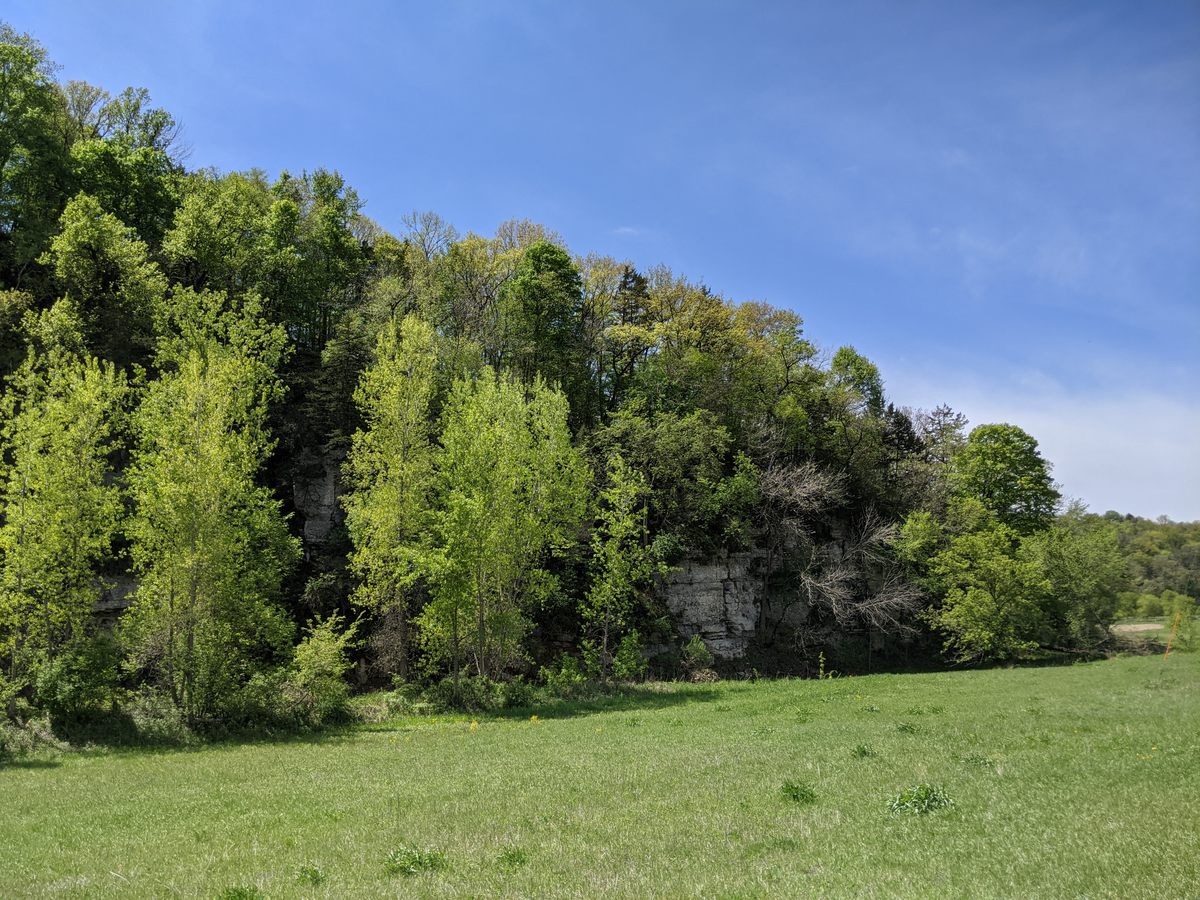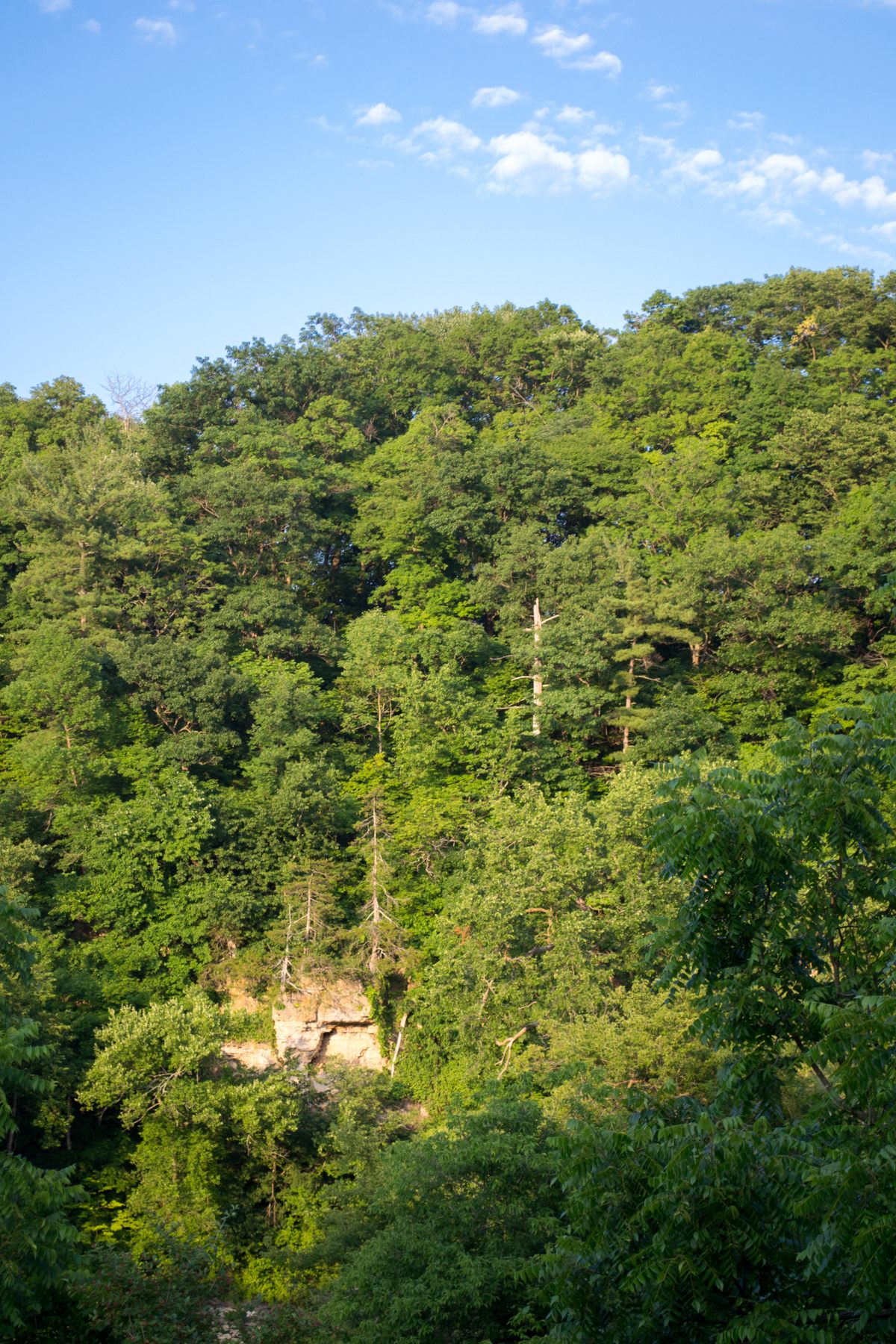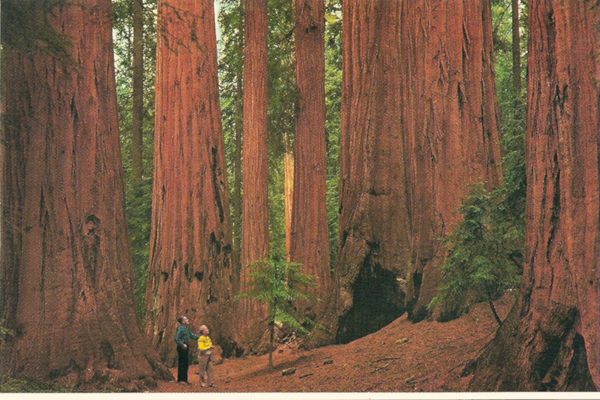The Ice Age Persists in the Upper Midwest, Where the Hills Breathe
In the Driftless, a rare combination of geological quirks has preserved ancient ecosystems. But climate change is coming.
A black Ford pickup truck speeds past on the gravel road, kicking up a wave of dust. Tim Yager shakes his head slightly and gestures to the forested hill behind us. “Most people have no idea this is here,” he says with a smile.
Yager, deputy manager for the U.S. Fish and Wildlife Service’s Upper Mississippi River National Wildlife and Fish Refuge, is going to take me back in time. He leads the way along a backroad in this quiet corner of northeastern Iowa. A small sign indicates the Fern Ridge Unit of the Driftless Area National Wildlife Refuge, but there’s nothing obvious to distinguish this place from the neighboring hills that bubble up from the narrow valley. The trail spirals up the steep side of the hill, from the warmth of a sunny late spring day to cool, dense shade. The forest is thick with oak, maple, and American basswood, its understory cluttered with the detritus of seasons past.
Yager stops suddenly and smiles again. He points off the trail, a little higher up the slope, to a spot where no trees grow. The living room-sized area, on the north side of the hill, is protected from direct sunlight. Its thick carpet of ferns seems to glow pale green, broken here and there by the sharp angles of bare or lichen-fuzzed limestone. “There it is,” Yager says, his voice soft with reverence. We’re looking at a micro-ecosystem essentially unchanged since glaciers blanketed much of the continent.

There are no woolly mammoths, but in tiny pockets of the Upper Midwest, the Ice Age persists. Plants and lichens that typically grow only far to the north, and insects and snails once thought extinct, are still hanging on in places like this. They’re able to survive thanks to microclimates created by a rare combination of geological quirks. Researchers and conservationists are racing to protect these unique sites from a variety of threats, including development and invasive species. But they acknowledge that their best efforts may not be enough in the face of climate change.
“Climate change is a big ‘if,’” Yager says. “Not only a warming temperature, but changes in precipitation might affect the whole amazing geology that exists here.” He adds: “Once it’s gone, it’s gone forever. You will never recreate those conditions that have been here for thousands of years.”
Ranging in size from just a few square feet to perhaps half an acre, these Ice Age refugia are known geologically as algific, or cold-producing, talus slopes. The conditions that led to their creation and persistence are global, regional, and hyper-local. During the Pleistocene epoch, which spanned most of the past 2.5 million years, Earth experienced a series of ice ages that periodically covered the Upper Midwest with glaciers. But a contiguous swath of what is now northeastern Iowa and southwestern Wisconsin, with narrow slices of neighboring Minnesota and Illinois, remained ice-free. For reasons not fully understood, as glaciers advanced and retreated repeatedly, they left this region virtually unscathed. The result is an area with a unique geology carved out in deep time, and free of glacial drift, the piles of rocky debris that big ice leaves behind: The Driftless.

“Almost all of the Upper Midwest had glaciers over the top, and glaciers are efficient at knocking down and filling up, flattening the landscape,” says Luke Zoet, a glaciologist at the University of Wisconsin-Madison. Instead of the open expanses that are synonymous with the Midwest, the Driftless region features tall bluffs, steep hills, and narrow ravines, thanks to rivers shaping the land for millions of years without the steamroller effect of glaciers. “Everywhere else in the Upper Midwest, glaciers reset the clock,” Zoet says.
Yager, an Iowa native, loves how one corner of his home state defies expectations. “When people think of Iowa, they’re not thinking about trout streams and deeply-incised river valleys,” he says. “They’re thinking corn and soybeans, from the Mississippi to the Missouri Rivers.”
The ice-free conditions of the Driftless gave species wiped out by glaciers elsewhere a toehold for survival, including several rare snails, and plants that otherwise exist hundreds of miles to the north, in Canada. But it’s the unique combination of geological phenomena which create the algific talus slopes themselves that make it possible for Pleistocene flora and fauna to persist in these special places even now. “Algific talus slopes are sort of a process,” says Zoet. “There’s breathing of the hillslope.”

The algific talus slopes where relic species persist are steep, built atop limestone—itself a relic from a time, half a billion years ago, when a shallow tropical sea covered what’s now the Driftless. The porous limestone is easily eroded by even slightly acidic water, including rain. As a result it holds numerous caves, sinkholes, cracks, and fissures. These networks of open spaces deep in the hillside were never compromised by glacial steamrollers, and are crucial for the “breathing”—slopes’ respiration.
In summer, warm air drawn in from near the top of the slope filters through those open spaces deeper in the rock. The air exits near the bottom, creating a microclimate up to 40 degrees colder than the surrounding area. In winter, the same system keeps the area around the vents warmer than the rest of the slope because the hill’s internal respiratory system holds a stable temperature, within a range of about 40 to 50 degrees Fahrenheit, year-round. That narrow range of temperatures on the slopes is why Ice Age relic species can persist at those sites, including plants such as northern monkshood (Aconitum noveboracense) and golden saxifrage (Chrysosplenium iowense), both listed as threatened, and a variety of ancient snails, most famously the endangered Iowa Pleistocene snail (Discus macclintocki), which was thought extinct until a researcher rediscovered a small population at an algific talus slope in Iowa’s Bixby State Preserve.

“I think it’s cool that the hillslope is essentially breathing, regulating temperature and moisture,” says Zoet. When all of the elements are present—a steep, north-facing slope of limestone that’s sheltered from summer sun, with rocky debris full of air pockets connected to a deeper network of open spaces within the hill, including a sinkhole or similar opening near the top of the ridge, says Zoet, it can create “a flow-through of air, from the top of the ridge, through the cave, and then out the side of the ridge at the talus slope.”
The power of these breathing slopes can be shocking, even for someone who studies them. Eric Carson, a quaternary geologist at the Wisconsin Geological and Natural History Survey, remembers the first time he got up close and personal to what are sometimes called ice vents. On a hot and humid summer day, when temperatures hit the low 90s, says Carson, “You’d get down into the low spots at the base, where the talus is, and the air was 40 degrees cooler.” He remembers when a colleague pointed his infrared camera toward the talus: “You just see these blue rivers of cold air coming out the base of the slope.”
“These sites are so cold that often trees won’t grow on them,” says Armund Bartz, a Driftless area ecologist with Wisconsin’s Natural Heritage Conservation Program. “It’s like Arctic permafrost, all the time.”

Similar ice vents occur in other parts of the world, mostly within a narrow latitudinal band of about 35 to 45 degrees North. And, while not technically the same as the Driftless sites, West Virginia’s Ice Mountain hosts its own population of Ice Age species. At Ice Mountain, which has an elevation of about 900 feet, “There are many rare plants in and around the ice vents that typically only occur above 4,000 feet in West Virginia, and are rare even at that elevation. They are true northern boreal species,” says Mike Powell, director of lands for The Nature Conservancy in West Virginia. The Nature Conservancy manages Ice Mountain and, says Yager, has also been instrumental in purchasing and protecting algific talus slope sites in the Driftless.
The Driftless sites remain unique, however, for their combination of geological phenomena. Ice Mountain, for example, lacks the sinkhole-cave-talus airflow of Driftless sites; there, instead, winter ice accumulates in the pockets between large boulders, cooling the surrounding air in summer.
The climate of the Driftless, during the Ice Age and now, is also perfect for these slope ecosystems, says Carson. “You have to be in a sweet spot climatically. Too far south, you don’t get enough ice and snow building up. If you go much north, you don’t find the geology,” he says. “There is absolutely no chance for these to exist anywhere else in the midportion of North America. It’s the lack of having been run over by glaciers that sets up the possibility of having them here in the Driftless.”

Of the few hundred sites known, many have been damaged or destroyed. Bartz recalls seeing a logging road cut through one slope’s midsection. Development and the spread of invasive species, particularly garlic mustard, are constant threats. Yager adds quarrying to the list. The limestone that makes the slopes possible has myriad construction and industrial uses. Even if a slope has been protected through conservation efforts, he adds, many of the sinkholes that are part of the natural air-conditioning system remain on private land.
“The sinkholes are basically the lungs for the algific slopes,” says Yager. Farmers often try to fill them in, usually unsuccessfully. “They like to use their equipment on a straight path and sinkholes are typically an obstacle to doing that. But, just like with a human, when you mess with the lungs of a system, it’s not a good thing.”
Foot traffic from the curious or clueless is another risk for the mini-ecosystems. “Don’t go hunting for them. Seriously,” says Carson. “They’re fragile. It doesn’t take too much hiking around on them to knock ’em out. The geographical footprint where these refugia species are living is tiny.”

Researchers and conservationists alike agree, however, that climate change may pose the biggest threat. “It really is a limited climate band where you get them,” Carson says. Even minimal warming, or an increase in drought, could cut off the hills’ airflow and destroy the rare microclimate.
“We hope, as has been the case since the Pleistocene era, that they will be able to survive and tolerate a warming climate,” says Yager. “But there are a few slopes that, from a temperature viewpoint, are right on the edge of what would be considered habitable by snails, and northern monkshood, and the many other glacial relics.”
Back at Fern Ridge, we venture no closer to the quiet, shaded slope of pale green ferns and Pleistocene relics. Instead, after appreciating it from a responsible distance, we creatures of the Anthropocene head back down the trail, carrying a sobering thought. For the Ice Age flora and fauna that found refuge in the Upper Midwest’s breathing hills, climate change may do what the glaciers did not.







































Follow us on Twitter to get the latest on the world's hidden wonders.
Like us on Facebook to get the latest on the world's hidden wonders.
Follow us on Twitter Like us on Facebook